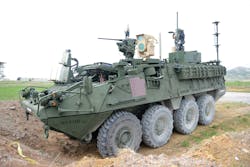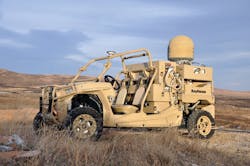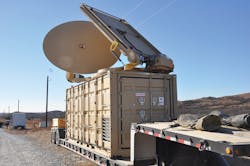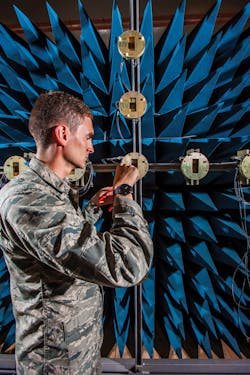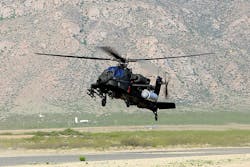By J.R. Wilson
By the late 2020s, the nature of warfare between global powers will be moving from guns and bombs to new weapons that are silent, invisible, and operate at the speed of light. One of those — cyberwarfare — already is operational and changing the face of combat.
In the next decade, joining cyber will be weapons that have been a staple of science fiction since the late 1800s, are highly classified-yet-well-known, and will challenge the viability of nearly every current weapons system and platform.
Directed-energy weapons come in two basic forms: high-energy lasers (HELs) and high-power microwaves (HPMs). While those sound familiar, however, real-world laser weapons have little in common with Martian deathrays, Buck Rogers rayguns or Star Trek phasers and a combat-level HPM weapon has only the most basic science in common with household microwave ovens.
“The definition we are using for HEL is laser sources above 1 kilowatt of power to thermally degrade a target at range; HPMs are a radio wave source that degrades the source in some way,” says Craig A. Robin, senior research scientist for directed-energy applications in the Army’s newly created Rapid Capabilities and Critical Technologies Office (RCCTO) at Redstone Arsenal, Ala. “Other services may consider directed-energy in slightly different ways; there is no firm definition for that term.”Army directed-energy weapons
The Army is far from alone in its interest in directed-energy weapons.
“The Navy has had the LaWS [laser weapon system] program and HELIOS [High Energy Laser and Integrated Optical-dazzler with Surveillance], China has a company that will sell you a 10-kilowatt system, the Brits and Germans have a number of efforts, the U.S. Air Force has the SHiELD [Self-protect High Energy Laser Demonstrator] program — there is a significant amount of work across the departments and the world,” Robin notes.
The timing and status of directed-energy weapon research and fielding by near-peer or peer adversaries is a growing concern and a spur to faster U.S. development. According to a recent U.S. Defense Intelligence Agency report on space threats, China is expected to deploy a HEL within the next year that could destroy U.S. satellites in low-Earth orbit — a particular threat to the GPS constellation on which the military relies for navigation, timing and precision targeting. While Russia also is working on satellite-killing weapons, China appears to be in the lead.
“China likely will field a ground-based laser weapon that can counter low-orbit space-based sensors by 2020 and, by the mid-to-late 2020s, it may field higher power systems that extend the threat to the structures of non-optical satellites,” the unclassified report reads. “China and Russia, in particular, have taken steps to challenge the United States [and regard satellite attacks] as a means to reduce U.S. and allied military effectiveness.”
In March 2018, Russian President Vladimir Putin announced a new HEL combat system — the Peresvet — about which he made somewhat grandiose claims without providing supporting evidence.“We have achieved significant progress in laser weapons,” Putin claimed. “It is not just a concept or a plan any more. It is not even in the early production stages. Since last year, our troops have been armed with laser weapons. We are one step ahead our rivals.”
Nonetheless, while the degree varies, there is a general consensus that the U.S. continues to hold the lead in directed-energy weapon development, with much of the technology advancement coming from commercial applications. For example, the automotive industry’s laser welder essentially is the same as a laser that can shoot down a missile.
The creation of the Army RCCTO earlier this year demonstrates just how seriously the Army is taking the development and deployment of directed-energy weapons.
“When RCCTO got the directive [from the Secretary of the Army] a couple of months ago, it was important not only to reduce duplication of effort across the Army, but also among the different services,” Robin says. “Our mission is to do rapid prototyping with residual combat capabilities for the Army — technology developed to put into the soldiers’ hands. Our definition of prototype is a unit of action — how will the Army use this to fight.”
Getting directed-energy weapons technologies into the hands of warfighters is a driving concern. “We recognize pivots in national defense strategy, and the Army created RCCTO to recognize the emerging technologies that make sense and leverage the investment we have to get capability to the soldiers,” Robin continues. “We’re not an R&D 6.1 or 6.2 operation. We’re also not a PEO [program executive office]. We will develop prototypes, make sure they are safe and suitable for soldiers to use, then transition those to the field.”Air Force efforts
While older than RCCTO by two decades, the Air Force Research Laboratory’s Directed Energy Directorate at Kirtland Air Force Base, N.M., is working toward the same goals in its research into HELs and HPMs, says the directorate’s Chief Scientist Dr. Don Shiffler.
“AFRL stood up in 1997 and formed the Directed Energy Directorate from older operations,” Shiffler says. “Our charge is to take directed energy out to the warfighter by 2020. The service labs are organized very differently. The Air Force is unequivocally ahead in high-power microwave research, with the only active program. All have laser programs, each meeting a different need, so it’s hard to say one is ahead or the other.”
In January 2019, Directed-Energy Directorate issued a broad agency announcement for the Compact High Energy Laser Subsystem Engineering Assessment (CHELSEA) project as part of an effort to make more powerful and efficient laser weapons suitable for next-generation tactical aircraft.
Technologies developed for the Air Force SHiELD project and its laser subsystem — Laser Advancements for Next Generation Compact Environments (LANCE) — will help design and build a technology readiness level-5 (TRL-5) prototype by 2024.
The Navy also is stepping-up its efforts to move directed-energy weapons from research to combat readiness. The defense 2019 budget requested $299 million for the Navy Laser Family of Systems (NLFoS) — a rapid prototyping, experimentation and demonstration effort quickly to provide ship-based laser weapon capabilities.The NLFoS projects of the U.S. Office of Naval Research in Arlington, Va., incorporates four major initiatives:
- Surface Navy Laser Weapon System (SNLWS) — A ship-mounted weapon system, including an HEL with an integrated low-power laser dazzler to counter enemy unmanned aircraft, fast attack boats, and surveillance and reconnaissance sensors;
- Optical Dazzling Interdictor, Navy (ODIN) — a near-term counter-surveillance capability, with two units installed on Navy guided missile destroyers in 2019;
- Solid State Laser Technology Maturation (SSL-TM) — A 150-kilowatt HEL demonstrator to be installed on a San Antonio-class amphibious transport dock ship this year to support future laser development; and
- Ruggedized High Energy Laser (RHEL) — an alternative 150-kilowatt system using a different laser architecture to pursue incremental increased capability
Defensive applications
Unlike other military weapons systems, there is a commercial aspect aimed at developing defensive directed-energy weapons — especially for major international airports.
“I’m pretty confident there will at least be a counter-UAV [C-UAV] system in the field in the next 5 to 10 years, if not by one of the services, then by commercial airports,” the Air Force’s Shiffler predicts. “Having a thousand-dollar drone shut down [London’s] Heathrow Airport at a cost of millions is simply unacceptable, so that will be first because there is such a need for it.”
Research also is underway at the U.S. Air Force Academy Laser and Optics Research Center (LORC) in Colorado Springs, Colo., where Senior Scientist Dr. Boris Zhdanov is pursuing diode-pumped alkali lasers, which he calls the most promising approach for various directed-energy applications.
In an interview with the Institute for Defense and Government Advancement (IDGA) in New York prior to that organization’s Directed Energy Systems Summit in June, he said “it is very important to start extensive research aimed at development of a high-power laser source producing a high-quality beam from a single aperture that allows it to destroy targets at very long distances.”
Threats to aviation safety
Countering the growing global threat to aviation safety and airport operations posed by cheap and easily acquired unmanned aerial vehicles — whether through operator incompetence or stupidity or malicious intent — is one of the prime goals of directed-energy weapon research.
Offensively, high-power microwaves are a serious threat to computer and other electronic systems on which every nation and military relies. high-energy lasers are more commonly seen as a way to drill a hole in a vital component — satellite, radar system, etc. — rendering the target inoperable. Defensively, high-energy lasers and high-power microwaves are seen as ways to deter incoming UAVs or missiles from reaching their targets.
Being silent and invisible, both types of weapons also have a stealth component, in some ways similar to cyberwarfare; it can be extremely difficult, if not impossible, to determine the source of an attack.“Generally speaking, lasers heat things up, which can cause damage. The best way to explain a high-power microwave is it scrambles the brain of electronics, but you can’t always tell why your computer is scrambled — is it the operating system, hardware components, a network server, a piece of software or an HPM,” the Air Force’s Shiffler explains.
One directed-energy weapon application — intelligence, surveillance, and reconnaissance (ISR) is receiving much attention because is considered offensive and defensive, albeit not necessarily destructive.
“One of the great advantages is ISR,” the Army’s Robin says. “When you have the ability to track and target, it provides a great advantage on the battlefield. With lasers, you have great optics that allow you to target, track, and identify threats — usually before they can target you.”
Laser power levels
High-energy lasers are being developed in a host of power ranges to deal with many different kinds of targets; lasers and high-power microwaves considered the best way to counter swarms of low-cost UAVs carrying explosives, drugs, or other offensive or illegal payloads.
“HEL gets talked about the most, with multiple missions from the 10-kilowatt class for C-UAV to incrementing up to 50 kilowatts to counter rocket-artillery-mortar [C-RAM]. You then scale up to the megawatt-class lasers for counter-ICBM,” says Michael Hofle, HEL product line lead at Raytheon Space and Airborne Systems in McKinney, Texas.
“The technology [on which Raytheon is working] that is most effective against swarms is our Phaser. It beams out high-power microwaves in a wide conical shape that will interfere with the electronic systems on board. The range is classified, as is the size of the beam. We’re working with the Air Force to deploy a Phaser system and our dune buggy system, which is on the cusp of transitioning from demonstrator to field ops within a year.”
HEL technology is broadly scalable on a multitude of platforms, using the same technology from 10-kilowatt systems to output levels still in the early stages of development.
“As power goes up, range and your set of applications increase, so you’ll be seeing higher-power lasers that will create new missions that weren’t available at the lower end of the power spectrum, Hofle says. “Right now, the Army is looking at the 50-kilowatt systems as their entry level, but we’ll be looking at higher and higher power through the 2020s.”
Even more powerful laser weapons are on the horizon. “There are programs being funded in the 150-kilowatt class that are mobile platforms,” Hofle says. “As the technology, not just for laser beams but power and thermal, continues to scale, 150-kilowatt lasers on large trucks are possible. As these lasers become more powerful and smaller, we’ll see significantly more powerful lasers on mobile platforms. That scalability and SWaP [size, weight and power] advantage also will be very important for airborne operations.”
Power always has been at the center of directed-energy weapon development, and resolving the complexities surrounding power remain vital to their future.
“There are two types of power: generating the laser and the power of the laser itself,” points out the Army’s Robin. “In the last 20 years, the science and technology community has improved the effectiveness of high-energy lasers by a factor of two. So we can now get militarily significant laser power onto a tactically viable platform.”Affordable laser weapons
Not only are laser weapons becoming more powerful, but they also are becoming more affordable. “It also gets you on the right side of the cost curve when dealing with low-cost, high-value systems like UAVs,” Robin says. “You also don’t have the logistics tail [of conventional weapons]. Military utility starts around 30 to 50 kilowatts and it makes sense to start prototyping at that power level.
One of RCCTO goals is to demonstrate capability at that level in prototype demonstrators.”
The Air Force Strategic Development Planning and Experimentation (SDPE) office at Wright-Patterson Air Force Base, Ohio, has tasked the 704th Test Group’s Directed Energy Combined Test Force (DE CTF) at Kirtland Air Force Base, N.M., to lead a directed-energy experimentation campaign. The 704th is an operating unit of Arnold Engineering Development Complex, headquartered at Arnold Air Force Base, Tenn.
The directed-energy combined test force grew out of the Air Force directed-energy weapons flight plan, designed to move directed-energy weapons to operational users. Part of the Flight Plan is the directed-energy experimentation campaign.
The objective of the initial directed-energy experiment at White Sands Missile Range, N.M., last October was to understand the capabilities and limitations of existing high-power microwave and high-energy laser weapons against small UAVs, explains John Cao, director of the directed-energy combined test force. The longer-term goal is far more comprehensive and complicated.
“The Department of Defense has demonstrated that directed-energy weapons can negate threats,” Cao says. “However, transitioning the directed-energy technology is a different story. We must also understand concept of operations, tactics, techniques and procedures, along with the potential implications to doctrine, organization, training, materiel, leadership and education, personnel, facilities and policy [DOTMLPF-P].”
High-energy lasers, once deployed, will provide several offensive tactical advantages. One potential application involves the Army AH-64 Apache attack helicopter in a special operations role of attacking power grids, high-value infrastructure, or moving vehicles.
Silent and invisible
“Those would be covert applications and the laser is well suited to that because you can’t see or hear it,” Raytheon’s Hofle says. “It really comes down to being able to maintain aim point so a very small beam — about the diameter of a bullet — can remain focused. The better you can do that, the more effective your laser is.”
Another big potential application for laser weapons is counter-UAV. Army officials are considering laser systems to protect fixed-wing aircraft like helicopters from shoulder-mounted rockets and rocket-propelled grenades.
“As we achieve higher powers, then we’ll be looking at counter-hypersonics and anti-ballistic missile, Raytheon’s Hofle says. “There also are some transitional applications, such as the ability to power beam — firing a laser across some distance and receiving that energy at the other end to power forward operating bases, for example, but those are still far off in the future.”
Laser beams have straight trajectories, so they can’t attack over-the-horizon targets. That also means laser weapons also could cause unintended damage beyond their targets.
“If we are doing range testing, we have to be cognizant of objects floating around in space, such as a satellite. Our laser system takes all that into account, so if we go through a zone where there is a known satellite, the system will automatically shut down in a test environment,” Hofle adds. “It’s a very low probability event, but is part of government policy. In a tactical environment, where we are actually shooting an attacking UAV, for example, that can be overridden.”
In another interview with IDGA, Harry Sinsheimer, Deputy director of the Joint Directed Energy Transition Office, said key directed-energy weapon objectives for the next two to five years include deciding what’s ready for deployment, and what are research and development priorities.
Early transition of HEL systems to the warfighter is vital to the mission of the entire directed-energy community, Sinsheimer says. The feedback, lessons learned, from the directed-energy system end-user (warfighter) must inform our direction for future investments in that regard.
Industry collaboration
DOD and government labs are working closely with industry, academia, and U.S. allies to quicken the pace of directed-energy weapon transition to the warfighter.
“We collaborate with our Five Eyes partners [Australia, Canada, New Zealand and the United Kingdom] and with other international partners. And it’s moving faster than I can keep track,” Shiffler says. “Each of our allies has their own strengths and weaknesses, but the UK has always had strong programs in these technologies.”
As to the Buck Rogers raygun or Capt. Kirk phaser, man-portable, if not exactly hand-held, directed-energy weapons are not high on the military’s wish list. “When it comes to lasers, the mantra has been more power. It’s certainly possible to build a man-portable system, but the market is more targeted around power levels that require some vehicle platform at 10 kilowatts and up,” Hofle says.
Many experts in the field agree that directed-energy weapons will be widely deployed for a range of missions by all the services — and a growing number of civilian facilities in another decade.
“By 2030, directed-energy will be hugely important. The soft, low-dollar, high-impact threats will only increase and we will need low-cost weapons to address that,” Hofle says. “Lasers are not the end-all that will solve all problems, but will be a vital, primarily defensive, part of the toolbag.”
Company List
U.S. Army Rapid Capabilities and Critical Technologies Office (RCCTO)
Redstone Arsenal, Ala.
https://rapidcapabilitiesoffice.army.mil
U.S. Air Force Research Laboratory Directed Energy Directorate
Kirtland Air Force Base, N.M.
https://www.kirtland.af.mil/Units/AFRL-Directed-Energy-Directorate/
U.S. Office of Naval Research
Arlington, Va.
https://www.onr.navy.mil
U.S. Air Force Academy Laser and Optics Research Center (LORC)
Colorado Springs, Colo.
https://www.usafa.edu/research/research-centers/laser-optics-research-center/
Raytheon Co. Space and Airborne Systems
McKinney, Texas
https://www.raytheon.com/capabilities/sensors
U.S. Air Force Strategic Development Planning and Experimentation Office
Wright-Patterson Air Force Base, Ohio
https://www.wpafb.af.mil
Institute for Defense and Government Advancement (IDGA)
New York
https://www.idga.org

